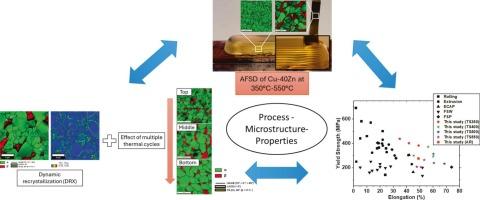通过固态添加剂搅拌摩擦沉积技术克服熔合黄铜增材制造的挑战
IF 7.9
2区 材料科学
Q1 MATERIALS SCIENCE, MULTIDISCIPLINARY
引用次数: 0
摘要
由于这些合金的挥发性元素和固有的高导热性,使用基于熔合的增材制造(AM)技术加工Cu-Zn合金(黄铜)提出了重大挑战。解决这些问题通常需要增加能量输入,修改激光系统,并调整成分以减轻锌的损失。然而,这些解决方案很复杂,仍处于发展的早期阶段。相比之下,添加剂搅拌摩擦沉积(AFSD),一种固态增材制造技术,提供了一个有希望的替代方案,以克服这些限制。这项研究代表了使用闭环温控AFSD沉积双相黄铜(Cu-40Zn)的开创性努力。系统研究了加工温度(0.38 ~ 0.61 Tp/Tm)沿构建方向和纵向对组织演变和力学性能的影响。由于反复的热循环,得到的显微组织主要由动态再结晶和后动态再结晶(P-DRX)控制。铜的屈服强度在215 ~ 437 MPa之间,延伸率在34% ~ 67%之间。纵向和纵向拉伸性能表明,晶界强化是提高力学性能的主要机制。沉积后的性能与锻造后的性能相当,因此强调了AFSD在制造高性能黄铜部件方面的潜力。本文章由计算机程序翻译,如有差异,请以英文原文为准。

Overcoming the challenges of fusion-based brass additive manufacturing through solid-state additive friction-stir deposition
Processing Cu-Zn alloys (brass) using fusion-based additive manufacturing (AM) techniques presents significant challenges due to volatile elements and the inherently high thermal conductivity of these alloys. Addressing these issues often demands increased energy input, modifications to laser systems, and compositional adjustments to mitigate zinc loss. However, such solutions are complex and remain in the early stages of development. In contrast, Additive friction stir deposition (AFSD), a solid-state AM technique, offers a promising alternative to overcome these limitations. This study represents a pioneering effort to deposit dual-phase brass (Cu-40Zn) using a closed-loop temperature-controlled AFSD. The influence of processing temperature (ranging from 0.38 to 0.61 Tp/Tm) on microstructural evolution and mechanical performance was systematically investigated along the build and longitudinal direction. The resulting microstructure was predominantly governed by dynamic recrystallization and post-dynamic recrystallization (P-DRX) due to repeated thermal cycles. The as-deposited brass exhibited a balanced strength-ductility combination, with yield strength ranging from 215 to 437 MPa and elongation from 34 % to 67 %. Tensile properties in longitudinal and build directions revealed that grain boundary strengthening was the primary mechanism for improving the mechanical performance. The as-deposited properties were comparable to those of wrought counterparts, thus highlighting the potential of AFSD for fabricating high-performance brass components.
求助全文
通过发布文献求助,成功后即可免费获取论文全文。
去求助
来源期刊

Materials & Design
Engineering-Mechanical Engineering
CiteScore
14.30
自引率
7.10%
发文量
1028
审稿时长
85 days
期刊介绍:
Materials and Design is a multi-disciplinary journal that publishes original research reports, review articles, and express communications. The journal focuses on studying the structure and properties of inorganic and organic materials, advancements in synthesis, processing, characterization, and testing, the design of materials and engineering systems, and their applications in technology. It aims to bring together various aspects of materials science, engineering, physics, and chemistry.
The journal explores themes ranging from materials to design and aims to reveal the connections between natural and artificial materials, as well as experiment and modeling. Manuscripts submitted to Materials and Design should contain elements of discovery and surprise, as they often contribute new insights into the architecture and function of matter.
 求助内容:
求助内容: 应助结果提醒方式:
应助结果提醒方式:


